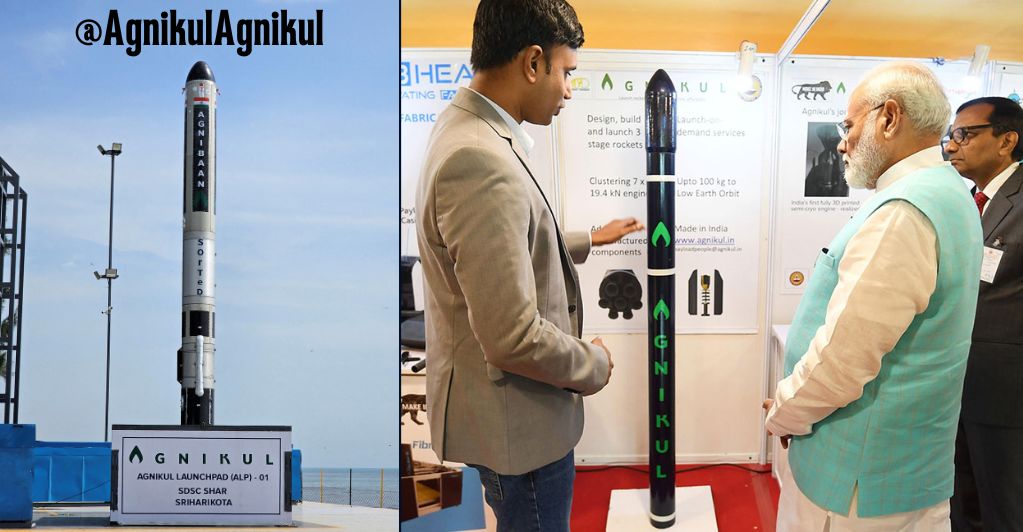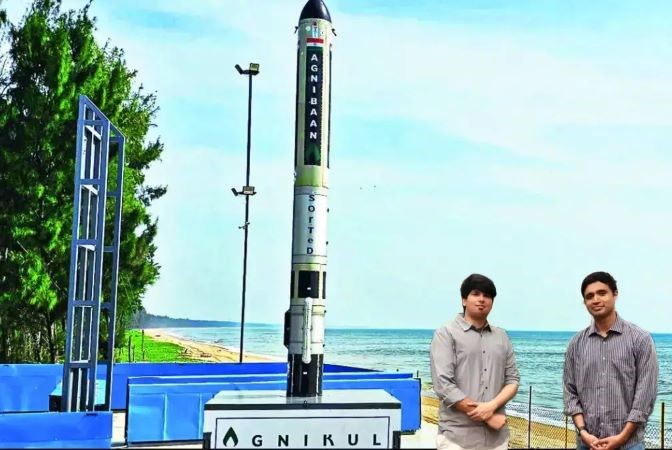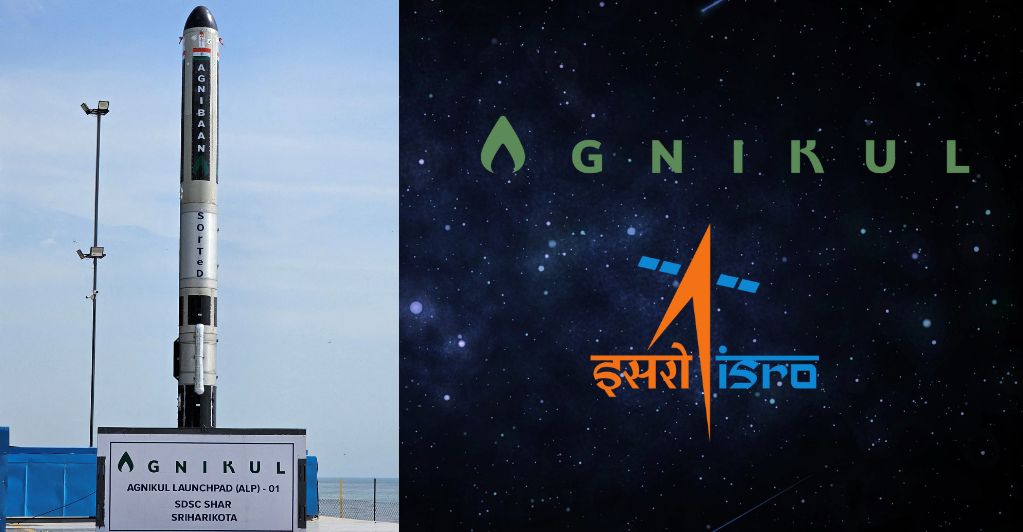
After overcoming several challenges, space tech start-up Agnikul Cosmos achieved a significant milestone on May 30 by successfully launching its first rocket, Agnibaan SOrTeD (Suborbital Technological Demonstrator), from its private launchpad within the Satish Dhawan Space Centre (SDSC) in Sriharikota.
Agnibaan SOrTeD is India’s second privately-built rocket and boasts several groundbreaking features. The launch, which took place at 7:15 AM, marks India’s first launch from a private launchpad and the world’s first single-piece 3D printed engine designed and built indigenously.
This is a major achievement for any private space center in recent years. Agnikul Cosmos plans to initiate launches in early 2025 following the successful test-flight of the Agnibaan rocket.
Table of Contents
- 1 Agnikul Cosmos Launched Agnibaan
- 2 Historic Achievement: Praises From ISRO and PM Narendra Modi
- 3 What To Know About Agnikul Cosmos Agnibaan?
- 4 Agnikul Cosmos Collaboration With ISRO
- 5 FAQs
- 5.1 Ques 1. How did ISRO show support for the Agnikul Cosmos Project?
- 5.2 Ques 2. What are semi-cryogenic engines?
- 5.3 Ques 3. What is the Agnibaan rocket?
- 5.4 Ques 4. What is the significance of Agnikul Cosmos’s recent launch?
- 5.5 Ques 5. What makes the Agnibaan rocket unique compared to other rockets?
- 5.6 Ques 6. How does the Agnibaan launch impact India’s space industry?
- 6 Conclusion
Agnikul Cosmos Launched Agnibaan
The Agnibaan rocket is a historical first since it is the first to be launched from a private launch pad, it is the first in the world to use a single-piece 3D printed engine, and it is the first to use a semi-cryogenic engine in a flight.
The Agnibaan launched successfully on Thursday, despite experiencing four postponements in the previous two months owing to technical issues, including a recent attempted launch on Tuesday that occurred five seconds before liftoff.
The Agnibaan is specifically designed to carry payloads up to 300 kg into an orbit roughly 700 kilometers above the Earth’s surface. This adaptable two-stage launch vehicle took off and flew for two minutes, peaking at 8,076 meters before plunging into the ocean.
Gathering vital flight data and guaranteeing peak system performance for Agnikul’s larger orbital launch vehicle, the Agnibaan, are the main goals of this suborbital flight. With a height of eighteen meters, the Agnibaan is designed for modest satellite missions and can carry payloads up to 300 kg into a 700 km low-Earth orbit.

Historic Achievement: Praises From ISRO and PM Narendra Modi
Agnikul Cosmos received great praise from ISRO and the honorable PM, Narendra Modi.
Prime Minister Narendra Modi hailed a significant achievement, declaring it a moment of national pride. “The successful launch of the Agnibaan rocket, powered by the world’s first single-piece 3D-printed semi-cryogenic engine, is a remarkable feat for India’s space sector and a testament to the remarkable ingenuity of our youth,” he remarked.
Srinath Ravichandran, Co-Founder and CEO of Agnikul Cosmos expressed gratitude, stating, “This success is the result of countless hours of reviews and hard work by our team.” Moin SPM, Co-Founder and COO, extended thanks to IN-SPACe and ISRO for their invaluable guidance and support, as well as to the startup’s advisors, investors, vendors, and customers.
What To Know About Agnikul Cosmos Agnibaan?
Agnibaan is a customizable, two-stage launch vehicle capable of carrying a payload of up to 300 kg into an orbit of approximately 700 km, according to its developers. Notably, this private space start-up has pioneered the use of a semi-cryogenic engine with a mix of liquid and gas propellants in its rockets—a technology yet to be demonstrated by ISRO.

The SOrTeD mission involves a single-stage launch vehicle demonstration powered by Agnilet, an indigenously developed semi-cryogenic engine utilizing sub-cooled liquid oxygen. This vehicle features the first-ever ethernet-based avionics architecture and fully in-house developed autopilot software from India.
It operates using sub-cooled Liquid Oxygen (LOX) and Aviation Turbine Fuel (ATF) and is equipped with four carbon composite fins for passive control. After liftoff, the vehicle is expected to perform a pitch-over maneuver approximately four seconds into the flight, rotating to a predetermined angle relative to the ground or its flight path.
At just over 39 seconds, it will execute a wind-biasing maneuver to compensate for wind effects on its trajectory. At 1 minute and 29 seconds, the vehicle is expected to reach apogee, the farthest point from the launch site, before splashing down just over two minutes into the flight, marking the mission’s completion.
Founded in 2017, Agnikul operates India’s first private launchpad and mission control center, with all other launchpads being managed by ISRO. In its broader ambitions, India aims to establish the ‘Bharatiya Antariksha Station’ by 2035 and send the first Indian to the Moon by 2040. The name Agnikul, derived from Hindi and Sanskrit, signifies fire.
Agnikul Cosmos Collaboration With ISRO
ISRO played a crucial role in the success of Agnikul Cosmos. They provided collaboration to the project which assisted them both financially and mentally. To perfect the technology and guarantee the Agnibaan SOrTeD launch’s success, Agnikul and ISRO collaborated closely.

This alliance is an excellent example of how public-private partnerships may advance space technology. Important collaborated achievements include the creation of the first single-piece, 3D-printed, semi-cryogenic engine in history and the first private launchpad in India, located in Sriharikota.
Overcoming Challenges For Agnibaan Launch
Agnikul Cosmos faced a lot of challenges to achieve the great milestone that everyone is proud of. They successfully overcame those challenges and now history knows their impact. Some common challenges they faced are as follows:
- Technical Glitches: The path to achievement was paved with difficult technological obstacles. Four efforts at launching Agnibaan SOrTeD were unsuccessful owing to different issues; each attempt served as a teaching moment.
- Resilience: To resolve these problems and guarantee the launch’s final success, the team’s resiliency and problem-solving abilities were essential.
- Significant Teamwork: With an average age of 23, the young engineers at Agnikul showed incredible perseverance and fortitude, highlighting the value of collaboration in overcoming obstacles.
WellHealthOrganic Buffalo Milk Tag: Your Ultimate Path to Quality, Nutrients, and Vitality
Amavasya In June 2024: Timings, Rituals, Significance, Dos, Don’ts, What To Know?
All Latest News
FAQs
Ques 1. How did ISRO show support for the Agnikul Cosmos Project?
Ans. ISRO provided mentorship, technical assistance, and facilities assistance to the Agnikul Cosmos Project of Agnibaan.
Ques 2. What are semi-cryogenic engines?
Ans. When compared to traditional engines, semi-cryogenic engines offer higher efficiency and cost-effectiveness since they combine cryogenic and room-temperature propellants.
Ques 3. What is the Agnibaan rocket?
Ans. The Agnibaan rocket is a small satellite launch vehicle developed by Agnikul Cosmos. It is designed to carry payloads into low Earth orbit and is part of India’s efforts to increase its presence in the commercial space market.
Ques 4. What is the significance of Agnikul Cosmos’s recent launch?
Ans. Agnikul Cosmos’s recent launch of the Agnibaan rocket is significant because it marks the successful deployment of India’s second privately-built rocket, demonstrating the growing capabilities and contributions of private companies in India’s space sector.
Ques 5. What makes the Agnibaan rocket unique compared to other rockets?
Ans. The Agnibaan rocket is unique due to its modular design, allowing customization based on the specific requirements of each mission. It also utilizes advanced 3D-printed components, which reduce production costs and time.
Ques 6. How does the Agnibaan launch impact India’s space industry?
Ans. The successful launch of the Agnibaan rocket by Agnikul Cosmos boosts India’s private space industry, showcasing its ability to compete on a global scale. It encourages further investment and innovation within the sector, potentially leading to more frequent and diverse space missions.
Conclusion
With the successful launch of the Agnibaan SOrTeD, Agnikul Cosmos took a significant step in the global space arena. Agnikul Cosmos may be considered one of the biggest milestones for India’s Private Space Sector.
It has also shown how private industry can contribute to the advancement of space technology. The startup is a shining example of India’s expanding potential and goals in the international space sector as it keeps innovating and reaching new heights.
